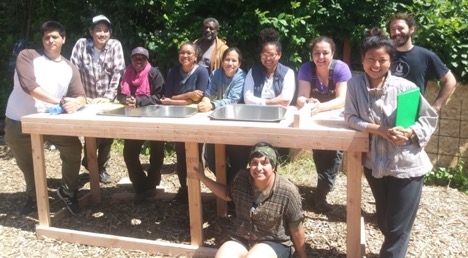By: Sam Serling-Sutton
This past May, I had the privilege of working with a group of farmers from Portland’s own urban farming nonprofit, Mudbone Grown. They approached us in the ReBuilding Center’s workshop to see if we could aid in the process of designing and building a “Wash and Pack” station, and while my carpentry career could graciously be described as “eclectic,” it has never once led me to build, let alone hear about anything akin to such a project. I was instantly on board.
On the first morning, the shop slowly filled with bleary eyes. Fifteen farmers-to-be milled around waiting to begin, waiting to be told what they were going to build and how they were going to build it. Luckily for them, we were all on the same page of nescience, which led us easily into the first step of successful design: dreaming. With no other direction than programmatic need, we separated into small groups and asked each to draw out ideal stations with no limitations.
What we saw out of these initial iterations were beautifully thought-out stations—some with drawers and roofs, others with hanging portions and shelves, and even one with a Rube Goldberg-esque contraption that washed and dried the vegetables on its own. Each idea was trotted out and presented in turn before we placed them all on a table and discussed them as a whole.
Design is about translation and communication. The process needs to be led through intention rather than pretension. It’s one of the most intoxicating processes I’ve found and one that I aim to replicate consistently in my life. Performing this as a group is instantly democratic. There isn’t room for form above function; for personalities before operations.
Over the course of the first day, we were able to make our way through about three more of these mini design-studios. At the end of the day, we had discovered as a group the shape and specifics of our Wash and Pack station! An entirely unique and bespoke piece of farming equipment that was soon to exist.
Between the first and second days, the Mudbone crew was tasked with following the cut list that they had created from their drawn-out plans and sections in order to purchase the necessary equipment. The station required mostly lumber, in addition to a few sinks—all of which was effortlessly corralled right here at the Rebuilding Center (the best part of doing a design-build here in the Education shop!).
With the bulk of the design work behind us, day two flowed much in the same way that the rest of our classes do. We were able to lead the team through a series of tutorials on safe shop usage in addition to training on measuring techniques, drill presses, chop saws, etc. The day was spent bringing our skills up to the level we needed in order to pull off our table in addition to a little more on-the-fly scheming and design (who would have thought sinks were so deep???).
The process of any design-build is, while continuously frustrating, endlessly rewarding. The process helps to demystify the built environment. It illustrates just how accessible our world can be despite often feeling exactly the opposite. A table isn’t anything more than four legs and a top. A house isn’t more than four walls and a roof. It’s all the same skills implemented at different scales. You take wood apart and you put it back together. If you can learn to do the first part safely and the second part carefully, you’ll begin to see that the universe is rich with these small coincidences.
By day three, the Mudbone crew and I had seemingly switched places. For one, it was my turn to show up bleary-eyed to their space. That morning, as I pulled up to their latest farm plot, I saw the 12 of them busily moving lumber and setting up tools, eager to erect their creation. I honestly can’t take any credit for actually putting the Wash and Pack station together—I don’t think I even touched a drill that day. It wasn’t three hours from the time I arrived that we were all happily standing around the completed station trying to design a roof structure out of our extra lumber!
While the specifics of this endeavor are a little different than the usual fare we have in and out of our Education shop it’s in no other way unique. It’s one of the thousands of things I love about the Rebuilding Center. The students who come through our shop are, without exception, outstanding. There is an eagerness and appreciation for the craft. The space that we have created here, tucked away in the back of our building, is something I’ve not witnessed in any of the other shops I’ve worked in. It is truly exceptional and I can’t wait to see what other incredible opportunities and experiences continue to emerge.




